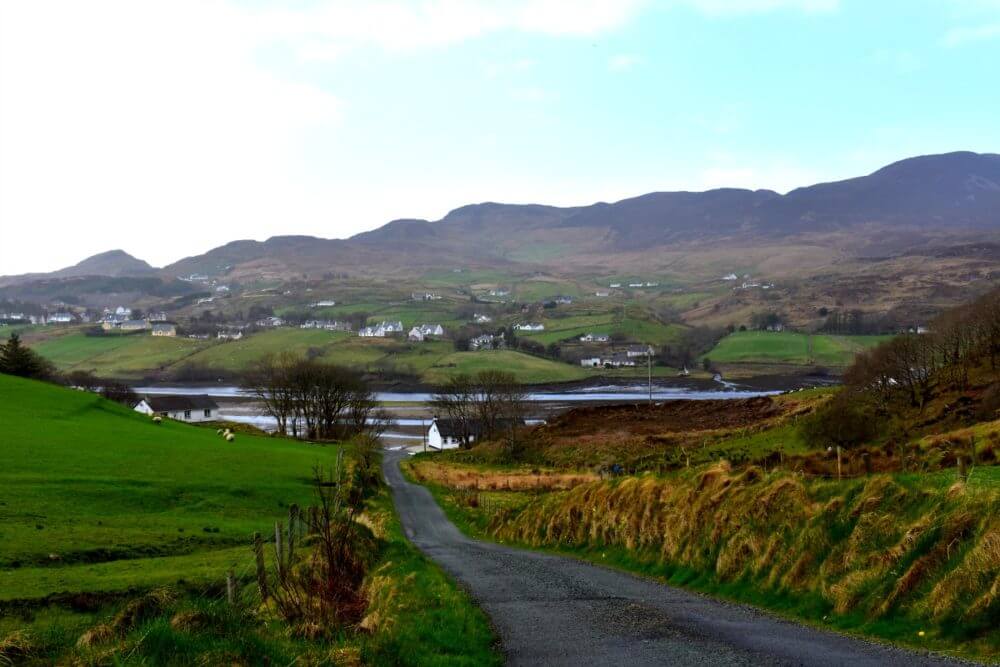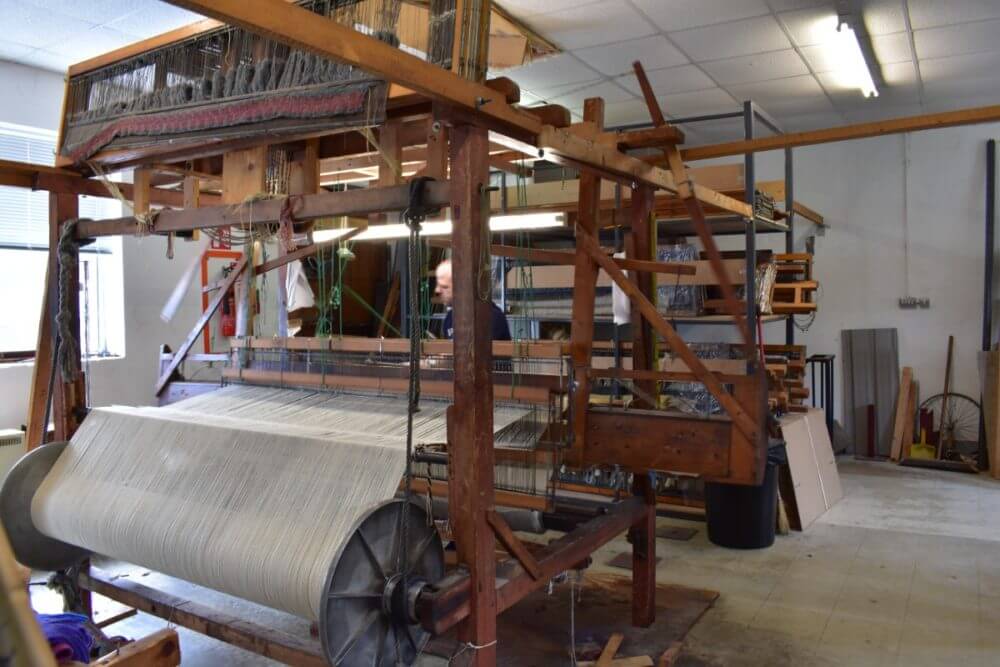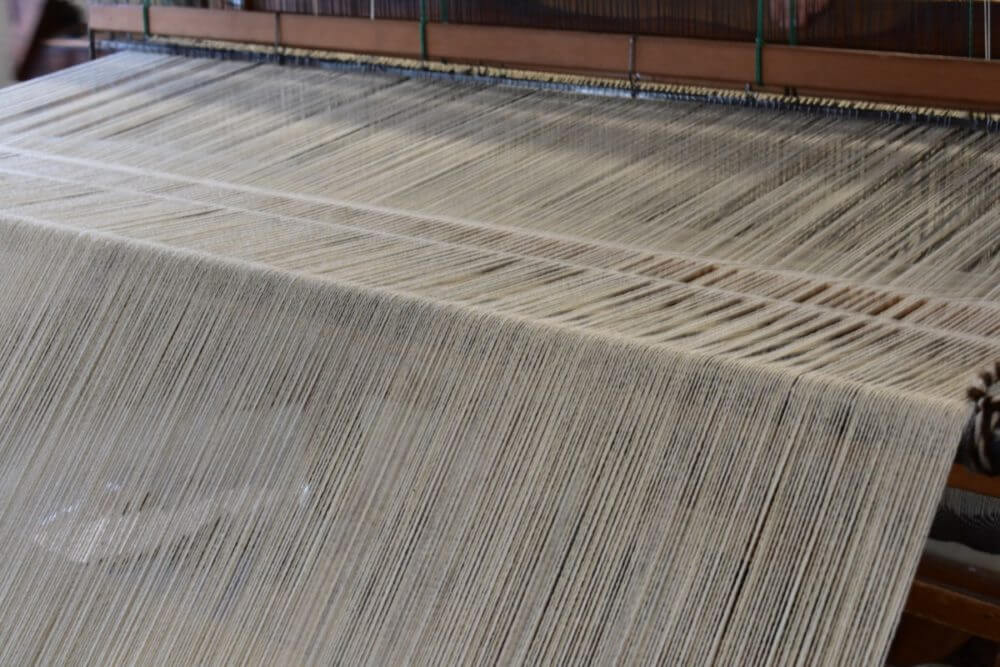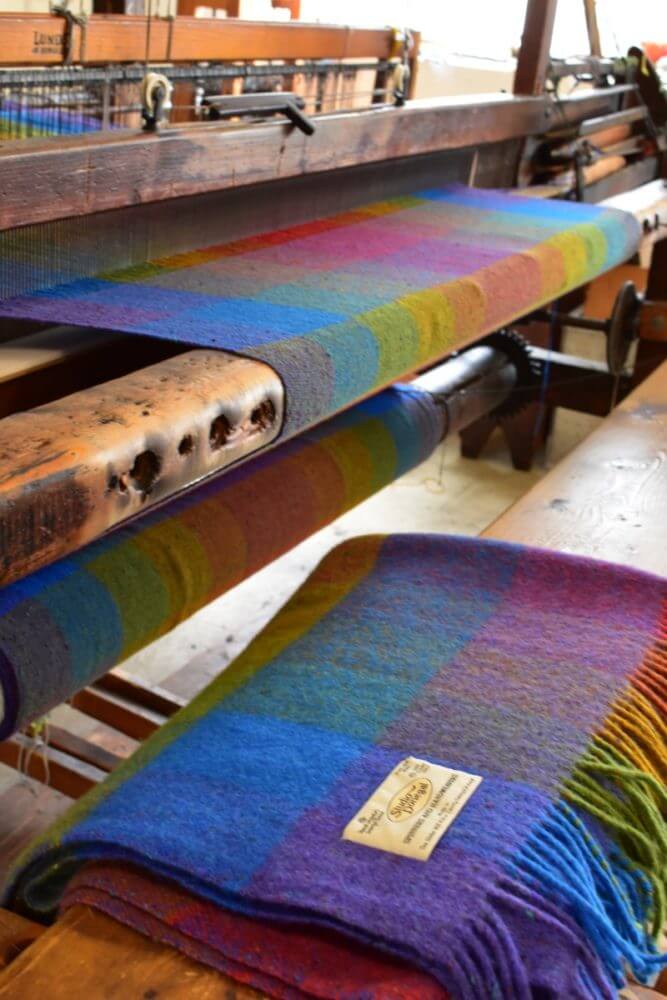
All photos copyright Michelle Escobar.
Couples are always looking to the newest trends to incorporate into their weddings, and that includes the illusive “wedding favor.” Whichever way you come down on this wedding tradition, hosting your destination wedding in Ireland affords you lots of opportunity to gift or even incorporate into your day some truly unique, amazing Irish details. One of those is Irish tweed!
This post will explore a bit about one of Ireland’s oldest traditions, looking at the history of tweed in Ireland, how it’s made, and how it can be the perfect addition for your dream destination wedding in Ireland!
What Is Tweed?
Tweed is a fabric made of wool that is usually naturally dyed and woven closely to create distinct patterns. It has been a commonly worn fabric among the farmers throughout Scotland and Ireland for many centuries, favored for its heartiness against the elements especially the rain and wind found in these parts of the world. The wool is water-resistant, making it a perfect choice for the climate in the area and the earthy tones from the natural dyes make it a great choice for hunting and outdoor sporting. Tweed fabric is commonly used for jackets, coats, skirts, and hats, and over the years has evolved to include full suits, vests, sports coats, and more.
Origins
Tweed’s origins are up for a little debate. The two prevailing theories postulate that tweed was (1) named after the River Tweed in Scotland, the cloth being made by the locals there in Tweed Valley or (2) a misspelling of the Scottish word “tweel” — the Scottish name for this style of woven fabric by a London clerk in 1826.
Tweed remains a popular fabric for Scottish and Irish people to this day. The largest production of tweed in Ireland can be found in Donegal, the northwestern part of the island that borders closely with Scotland.

This reliable and sensible fabric drew the attention of British aristocracy in the early 19th century. As nobles and wealthier gents ventured out into the elements for sport (think riding, shooting, fishing, etc.), they were in need of some sturdier material to withstand the harsher elements of the Scottish and Irish countryside. The simple tweed patterns that served farmers and the working class were transformed into beautiful patterns and color like herringbone and houndstooth and bright festive plaids. Soon it was as equally a mark of wealth to own a proper tweed suit, hat, and even dress for the ladies! By the middle of the 19th century even the middle class took to the tweed, the clean presentation — a mark of wealth and success — but still retaining the practicality and sensibility of the fabric’s origin that can keep the working class working.
Scottish and Irish tweed are for the most part similar in theory, but each has its own difference to note as well.
Harris Tweed is the Scottish tweed. It is made in the Outer Hebrides islands of Scotland (the islands in the west) from pure virgin wool that is dyed with natural dyes on these islands — as per the Harris Tweed Act of 1993. Harris tweed gets it distinctive deep red, purplish-brown, and rusty orange colors from the lichens and vegetables found in the area.
Irish tweed is known as Donegal Tweed. It is wool from the Donegal sheep (which if you’ve ever been to the area are found aplenty) and naturally dyed with the local blackberries, fushsia, gorse, and moss to give their distinct coloring. Irish tweed also tends to work in more different kind of patterns like herringbone, check, and chevron-style patterns in varying sizes. Donegal Tweed actually prides itself on creating varied patterns of size, shape, and colors mixed in which creates a really fascinating tapestry of colors and textures in the finished product! The most recognizable pattern of Irish tweed is the donegal pattern (spelled purposely with the lower case d) — small pieces of different colored yarn that are woven in different intervals to create angles in the patterns.
How It’s Made
On my recent trip to Ireland I had the pleasure to go visit the world-famous Studio Donegal in Kilcar, Co. Donegal. They have been making Irish tweed since before the 1700’s, all in the traditional way of gathering the raw wool, natural dyes, and hand weaving the textiles. With advancements from the Industrial Revolution and eventually the power looms of the 1960’s threatening to kill a time-honored tradition, Studio Donegal stayed true to their craft and realized the importance of preserving it as both a means of employment for the local people as well as preserving their national identity in a way. Making these items are more than just weaving a pattern and selling a blanket; it’s about working with the local farmers to sell the wool, gathering the natural dyes from the land and importance of preserving that ecosystem, and finally connecting generation after generation with a tradition of their culture. To this day, Studio Donegal proudly make their products through traditional means.
And if you get the chance, a visit is really worth it.
It is a craft incredible to behold in person: monstrous wooden looms creek and rattle at a rhythmic pace, singing an ancient song passed down from generation to generation as the yarns are bent and tucked and pushed into place by the pattern. The end product is not just a pretty blanket or coat; you can smell and see the colors of the earth, the energy from the creation process almost seems to pulse through.

Just one of the incredible hand looms Studio Donegal has in production. This is their oldest loom — almost 100 years old believe it or not!
The weaving process is fascinating. Weft threads are interlaced with warp threads to create the pattern.


(Above) Notice the heddles in he top left area. Heddels are a huge part of a loom — a warp is threaded through the eye of the heddle which then helps to separate the warp threads from each other so the weft can pass through and not get tangled. Each heddle holds one warp, which means you need that many to create your end product. To give you an idea, around 300-400 heddles are used to made a tea towel. Now imagine how many you need for a blanket! And you have to thread each one by hand!

Patterns are pre-termined. Each loomer will choose the pattern they will weave before they begin and adjust the beams and loom accordingly. I was surprised to find how mathematical some of the patterns can be! Patterns of numbers and re-positioning help create the distinctive patterns Irish tweed is known for. It was incredible to see the loomers memorize these patterns not by counting, but by RHYTHM. They memorized the patterns like a dance, moving their feet at the base of the loom in concert. It was astounding.

You can see the process of making one colorful blanket. Each yarn was colored and then individually threaded to the heddle then woven in a square plaid style pattern.

After the fabric is woven, it is taken to the stitching room where it’s cut and finished to size. This also is done by hand for every single product. Garments are measured and stitched entirely by hand, blankets are cut and finished then neatly folded and presented ready for sale. Here’s an example of one of the more popular blanket patterns on the loom being made and the finished product on the bench.

All photos copyright Michelle Escobar.
On Your Wedding Day
We love the idea of incorporating Irish tweed into your wedding day! There are so many ways it can work and it really adds a classic, authentic “something Irish” to your day that will be very well received and photograph beautifully. Here are just some ideas to get you started!
Suits & Coats
Get fitted in an authentic Irish tweed suit as both look and incredible keepsake you can bring back from Ireland! Custom suits can be tailored to your exact fitting. You can pick the pattern and fabric and really make it your own and it will photograph incredibly. Take it a step further and extend the offer to your best friends and groomsmen, father and father of the bride as well! Waterlily Weddings has some outstanding tailors and suit makers we can recommend and we can help plan a fun event out of it for you!
Welcome Gifts
All of your guests are going to be enjoying the island on their visit. Get them into the spirit of adventure with some good supplies, including tweed accessories they can use both on your wedding day and the rest of the trip! Tweed hats are a wonderful gift for all ages and guys and gals. Softer shawls and blankets are perfect to brace against the wind especially if you plan to host an outdoor ceremony. These are not only function for your wedding day but they can use them throughout their trip and as a keepsake!
Socks To Warm Your Toes
If you want a smaller and quirkier tweed gift, think about gifting a pair of tweed socks! Made in an array of bright colors, these comfy socks will surely keep their feet warm after they dance the night away at your wedding and beyond. Custom colors, fun patterns, and more can be coordinated to fit with your theme.
These are just a few ideas to get you going. Waterlily Weddings has even more suggestions on how you can incorporate Irish tweed into your wedding experience. With talented vendors and artisans throughout the island, we work closely with nothing but the best to deliver those unique details that will distinguish your wedding from the rest.
*All photos copyright Michelle Escobar and cannot be reprinted or published without express permission.
comments +